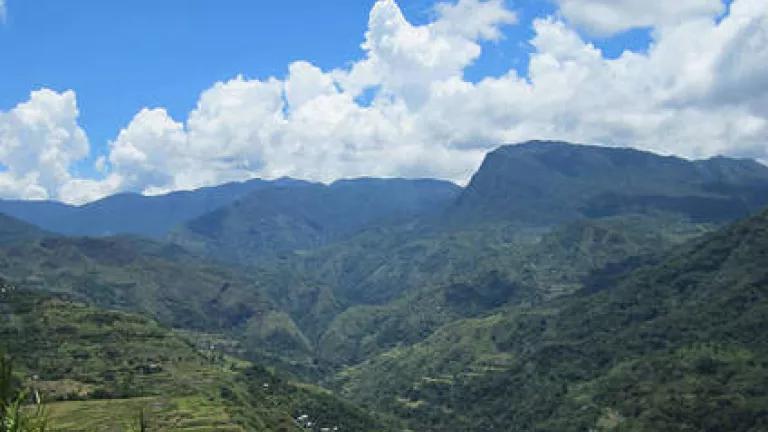
On its face this meeting was a modest local gathering about small scale mining in the region, but in fact it is a harbinger of important changes coming to small scale gold mining not only in the Philippines, but throughout the world, as small scale gold mining takes on the challenge of going mercury-free. In the Philippines, a new Executive Order (EO 79) recently banned the use of mercury in small scale gold mining. Further, should the Philippines sign onto the new Minamata convention as expected, the country’s commitment to reduce or eliminate mercury in the small scale mining sector will become a matter of international law. The Kalinga summit brought together stakeholders to discuss the challenges of making this transition. But as usual, the summit revealed that the issues facing small scale gold miners go well beyond the technical issue of mercury use. The new executive order also limited areas open to small scale mining (called Minahang Bayan or People’s Small Scale Mining Areas), and to the dismay of many small-scale miners, it upheld the mining law that (in their view) favors large-scale mining. EO 79 also pushes for putting provincial or city mining regulatory bodies into operation, bodies that many small scale miners perceive as biased toward large scale mining interests. The summit reinforced the lesson that the problem of mercury use in small scale mining cannot be solved in isolation from the broader issues touching the legitimacy of the small scale mining sector overall.
After the summit concluded, I was invited to visit the Ga’ang mining area, in Balbalan municipality, where the use of mercury in small scale mining was recently prohibited by local authorities. The site has now nearly completely converted to mercury-free methods. The mining area is controlled by a tribal group called the Banao Bodong Association,

which has asserted its rights as an indigenous people to control the exploitation of natural resources in the tribal area. And control it they do. The area is very tightly administered. Mining is limited to tribal members and to residents of three “privileged” local communities. Miners must have a permit to enter the site; miners must pay a fee for each tunnel they exploit and for each rod mill they operate; no youth are allowed in the area except during school vacations; and no alcohol is permitted in the mine area. And now, no mercury use is allowed. There are stiff penalties for anyone caught using it.
I was excited to see this mercury-free operation in action, but I had to work for the privilege. To reach the mine site, we had to make a steep and treacherous trek 4.5 miles up the side of a mountain – a very challenging and in some places frightening ascent for me, but one that is easily navigated several times a day by the local haulers that carry all goods to the mining area from the closest local village, Sesec-An. Everything must be hauled in by hand, from soda pop and soap to large steel rod mill drums.
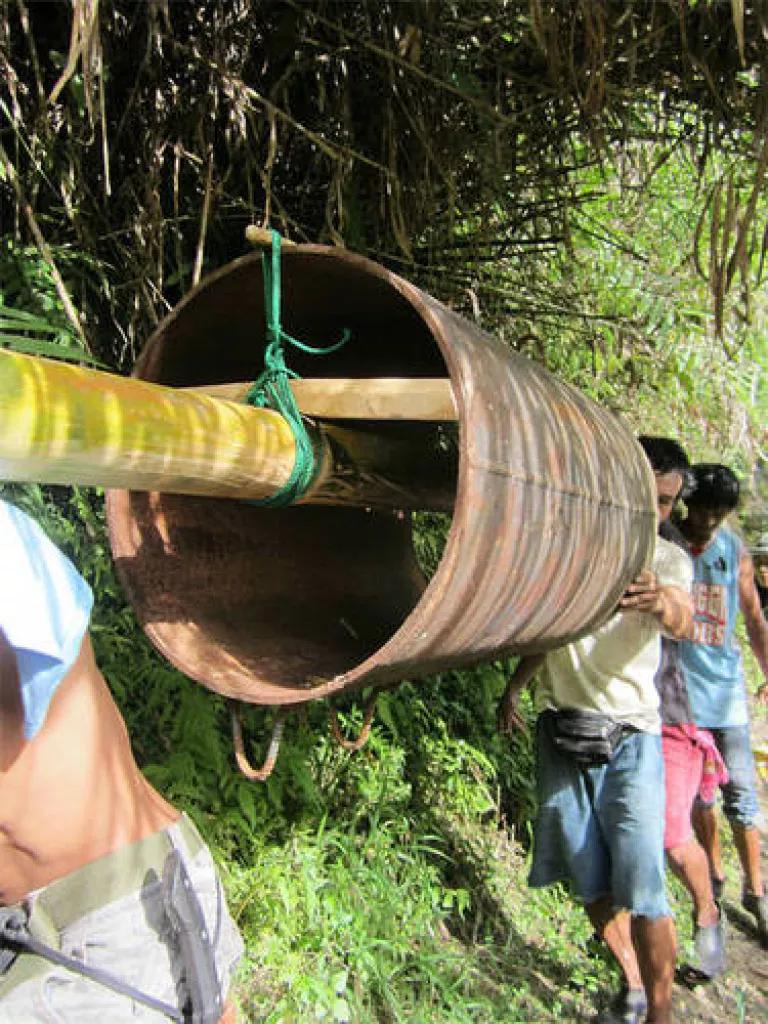
I asked why the local authorities do not improve the passage, to make it easier and safer for the miners and their suppliers to reach the mining site; the best speculation is that the elders and leaders want to intentionally keep the site remote and difficult to access, in order to maintain control over the site. As we hiked through the forest, our host and guide, Ms. Juliet, was quietly whispering to herself, and later told me that she had been whispering to spirits who live there, asking for our safe passage. “You cannot ignore them” she said and I believed her. I definitely needed all the help I could get to finish the journey.
Emerging from the forest after our long hike, we came upon a mining camp that was completely different than any I had seen before. I was struck by how cozy and almost pastoral it seemed. The mining tunnels were unobtrusive and sometimes even hard to spot, dug into the side of the mountain, hidden by the lush greenery. The mining camp itself, with processing areas, small shops and living space, consisted of a series of small structures tightly hugging the side of the river. Most impressive was that nearly all of the operations were run by hydropower, using water diverted from the river. Waterwheels made from old tires were used to turn to the rod mills.
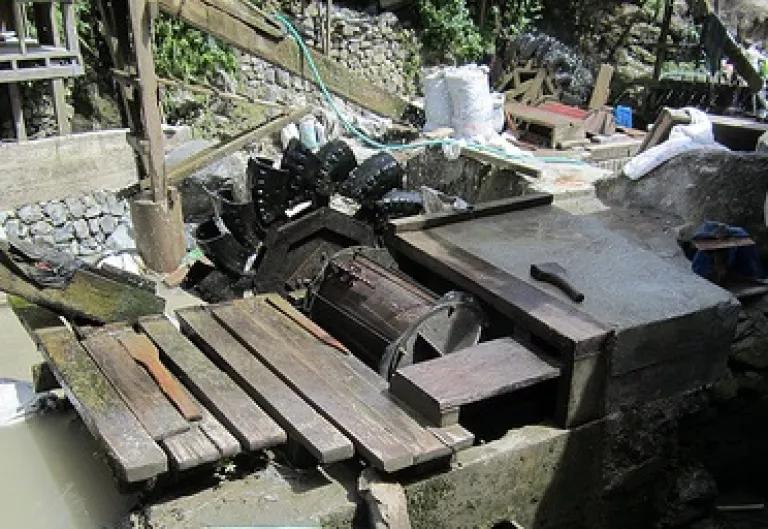
The dominant sound in the mining area was the soft thwap thwap thwap of water wheels turning and splashing water as scores of rod mills positioned along the river quietly ground tons of ore. I’ve never seen a camp appear more tidy and well-ordered, decorated both with natural flower gardens and with plastic flowers crafted from recycled soda bottles. As one friend put it, it was as if the mining camp had been built by the Swiss Family Robinson.
Later that day, we were able to visit processing operations and talk to the miners. (I was not allowed to visit the digging operations, because it is considered bad luck for women to go into the tunnels.) Until this year, the miners used a process that involved a minimal amount of concentration achieved by washing the ore with a hose on an inclined plane, a process which concentrated the coarse gold but undoubtedly lost a lot of fine gold to the wash water. The resulting washed ore was then amalgamated with a large quantity of mercury. In contrast, with the new mercury-free set up, coarse gold is still separated with an initial wash but the wash water is then flowed over a carpet-lined secondary sluice to capture finer gold.
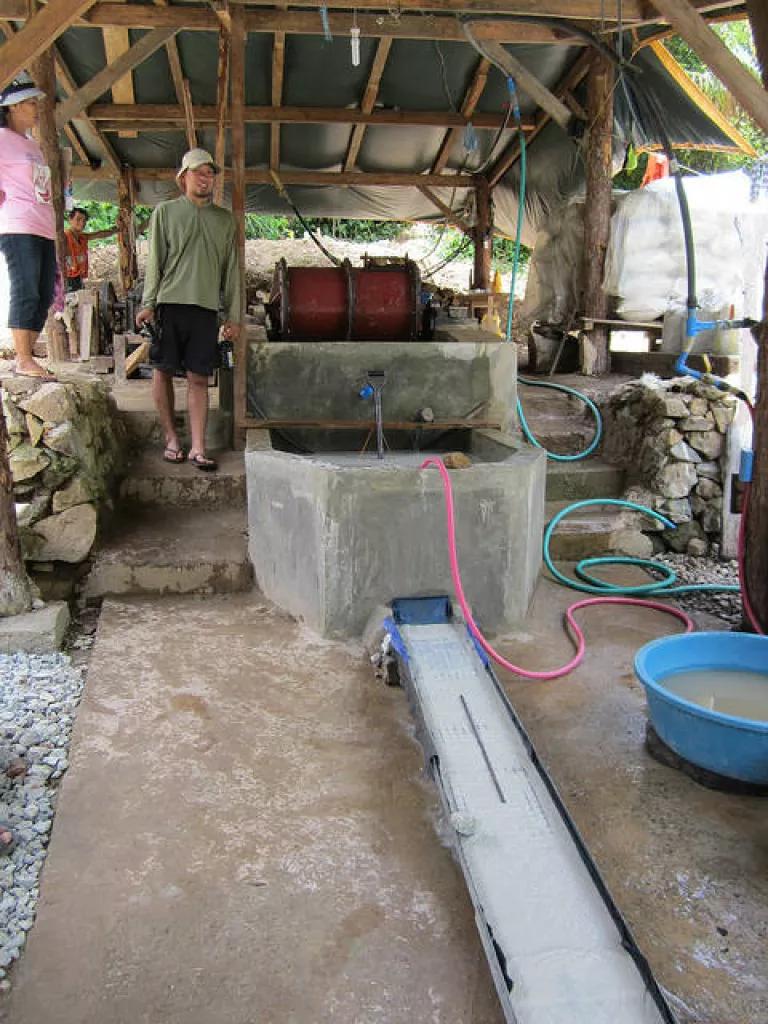
Also, the tailings from this process are sometimes retained in a pond to be reprocessed (although ultimately water and tailings are discharged into the river, as attested by the river’s milky white color). The resulting concentrate is then panned by hand, and then directly smelted to about 14 to 16 karat gold. Overall, the operations I saw seemed efficient, well-run, clearly profitable and blessedly mercury-free.
A number of reinforcing factors have likely contributed to the near-elimination of mercury from this mining site. First, my colleagues at the Filipino environment group Ban Toxics! provided intensive education and campaigning about the negative health and environmental impacts of mercury in the community. This outreach clearly made a big impression: ask any miner now in Ga’ang about mercury and he or she will recite the litany of its dangers. Second, the price of mercury has skyrocketed locally in the past few years. Mercury is currently sold locally at US$728 per kilogram (world market price is currently around US$50 per kilogram). So, the idea of no longer having to buy mercury certainly has its appeal. But maybe most importantly, the folks at Ban Toxics! also provided education on the use of mercury-free techniques, emphasizing enhanced gravity methods. They teamed with a group of miners from nearby Benguet province, who had already converted successfully and profitably to mercury-free methods, to help demonstrate the techniques. Critically, these alternative methods actually yielded more gold than the old mercury-based techniques. More gold makes a big impression, too (obviously). So, in summary: the miners had the opportunity to switch to a process that gives them more gold, without having to buy an expensive input like mercury, and without having to expose themselves to a highly toxic chemical. A “no-brainer” if there ever was one.
What can the rest of the world learn from Ga’ang? Is this place a special case, or are there lessons here that can be applied to small scale gold mining sites in other locations? No doubt there are distinctive features about Ga’ang that have supported the widespread adoption of mercury-free techniques, such as strong social cohesion, clear control by the local tribal association, a successful awareness campaign about the toxicity of mercury, and the very high local mercury prices.
But my hunch is that it all comes down to the gold. The Ga’ang miners simply get more gold now than they did before, and that is strong motivation to change. But it is critical to understand that the mercury-free process adopted in Ga’ang works well because of the nature of the gold ore found there. When the initial concentration of gold in the ore is relatively high to begin with (about 1 g gold per 50 kg sack of ore in Ga’ang), it is feasible to use rudimentary (but effective) gravity-only techniques to further concentrate the ore to a level high enough to be smelted directly. And I can personally attest that these miners are able to produce a lot of gold this way. We got an eye-popping demonstration of this high productivity when we visited some miners who were busy smelting the fruits of two weeks of labor.
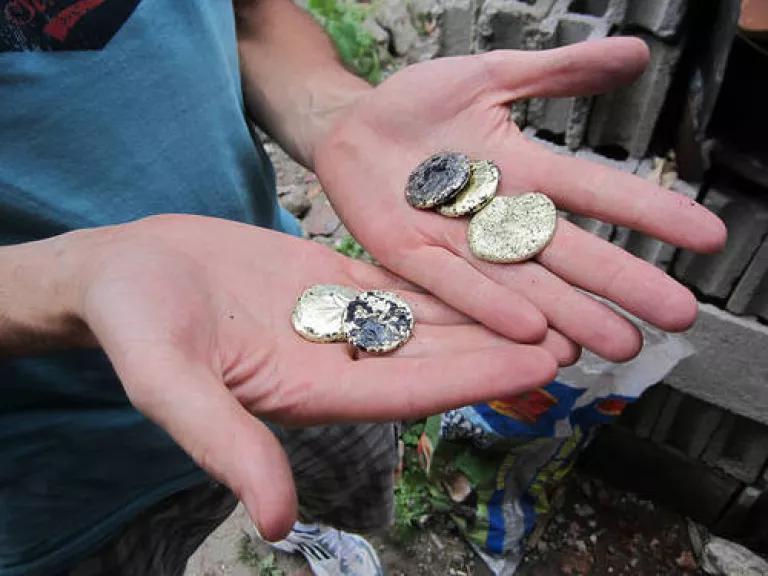
They estimated they would get around 500 g (half a kilo) of gold from one tunnel for the two week period. While it is true that this effort involved a big team (about 40 people) producing the ore, still. Wow. They let me hold the gold ingots they had produced so far - about 250 g. There I was, staring at around $10,000 worth of gold resting heavily in the palms of my hands, and they were only half way through. With results like that, it shouldn’t be very hard to convince people to change processes.
Nonetheless, for some miners, change is still hard. The miners I spoke with admitted there is still surreptitious use of mercury in Ga’ang. They speculated that those still using mercury are short-term miners looking for quick cash – they are not concerned with getting the most gold they can get from ore, but rather getting gold fast, even if they leave some behind. But miners with longer term interests see things differently. For those of us looking to help miners transition away from mercury, it is worth remembering that this is an ongoing process, even in the best of circumstances like in Ga’ang. Changing attitudes and habits will not happen overnight.
And there are other troubles on the horizon for the tribe, beyond mercury. I was not surprised to learn that this gorgeous terrain overlaps with the Balbalasang-Balbalan National Park – another typical conflict that often arises between local people and national-level interests, who want to develop the tourism potential of the region. The Philippine government must find a way to balance its aims in establishing a national park with the rights of the tribe in their ancestral domain. Unfortunately, it seems this issue will play out long after the mercury problem in the area is over.
The story of Ga’ang’s transition to mercury-free mining may offer an inspiring blueprint for other similar mining sites, but given the particular confluence of fortunate conditions that have favored the mercury-free transition there, I don’t think it offers a one-size- fits-all-solution. But the experience does prove, without a doubt, that when there is deep understanding of the local situation (including the technical and social environment in which miners are working), and when solutions are tailored to fit those local circumstances (including mobilizing miners themselves), the results can be astonishing.

